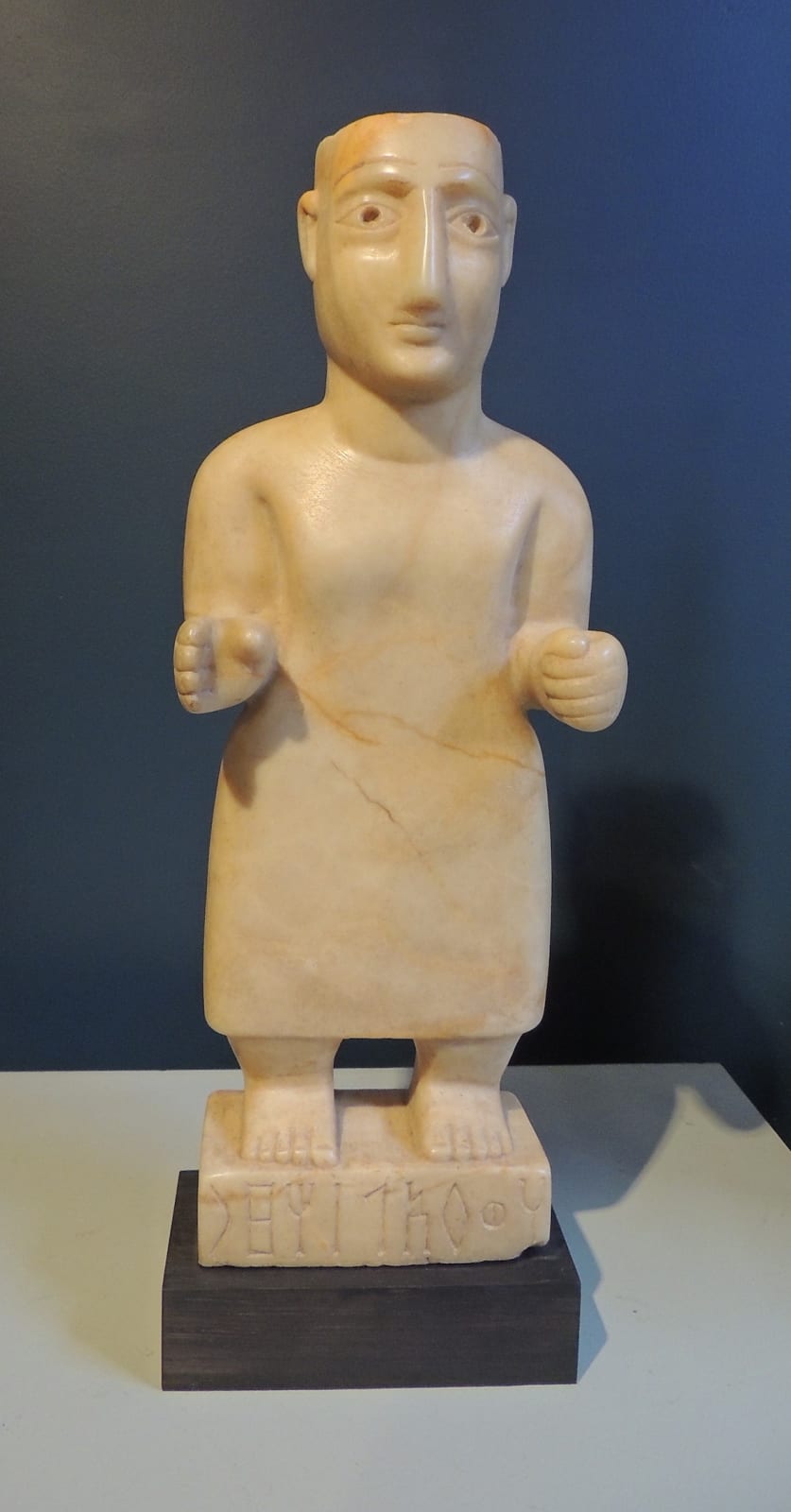South Arabian alabaster male figure, 200 BCE - 100 BCE
Alabaster
height 40.6 cm
height 16 in
height 16 in
CB.2943
Standing with his feet parallel on an integral rectangular plinth, his arms held at his sides with the elbows bent acutely, the forearms projecting forward, one hand held into a...
Standing with his feet parallel on an integral rectangular plinth, his arms held at his sides with the elbows bent acutely, the forearms projecting forward, one hand held into a fist was holding an object, currently lost, whereas the other is open into a gesture. He is wearing a very simple calf-length garment, his broad oval face with a small mouth, a broad well-chiseled triangular nose and large almond-shaped eyes, the pupils incised, with arching brows, the crowning of the head roughly finished at the top and back, where most probably hair or a headgear, currently lost, was separately modelled and placed. The back side of the sculpture is smooth and unnaturally flat. A regular well-carved inscription on the front panel of the plinth bears the person’s name and was used as to identify him.
The ancient territory of South Arabia was located on what is currently the modern Republic of Yemen though including also parts of today’s Saudi Arabia and southern Oman. The south-western part of the Arabian Peninsula has also been an important centre of culture, with several important kingdoms flourishing in the region at different times between 1000 BC and the rise of Islam in the 6th century AD. The oldest and most important of these was the kingdom of Saba, which is referred to as Sheba in the Bible.
The region was extremely famous in the ancient world as it enjoyed the monopoly on two of the most prized materials of ancient times frankincense and myrrh, two aromatic resins which grow only in the territory of eastern Yemen, southern Oman and Somaliland. and which constituted an important source of wealth, as their exclusive production and trade was in the hands of the ancient south Arabians. Latin geographers used to describe the southern part of the Arabian peninsula as Arabia Felix (“Fortunate Arabia”), because of its fertility, as it was enjoying more rainfall at the time. One of the characteristics of ancient South Arabian culture was the great attention paid to representing humans and animals in sculpture. The most common type of sculpture of South Arabia is statuettes of humans which were in all probability placed as markings above their tombs or in temples as votive offerings. When dedicated to a sanctuary these statues were considered as acts of piety, invoking the favour of the gods, at the same time being an indication of the donor’s wealth and social status being thus on public display. In regards to the sculptures of humans, the variations in detail, the style of their robes and the facial appearance mostly suggest that there was a real effort in trying to represent real-life individuals but in a general style and using materials and techniques which are typical of the ancient South Arabian art. Such statuettes also provide details of the type of garments and hairstyles used by the locals. Sculptures were mostly carved from a fine calcite-alabaster and whereas in most other societies of the ancient world sculptures were coloured, in ancient South Arabia this stone was considered sufficiently beautiful in its own right to be left unpainted.
The ancient territory of South Arabia was located on what is currently the modern Republic of Yemen though including also parts of today’s Saudi Arabia and southern Oman. The south-western part of the Arabian Peninsula has also been an important centre of culture, with several important kingdoms flourishing in the region at different times between 1000 BC and the rise of Islam in the 6th century AD. The oldest and most important of these was the kingdom of Saba, which is referred to as Sheba in the Bible.
The region was extremely famous in the ancient world as it enjoyed the monopoly on two of the most prized materials of ancient times frankincense and myrrh, two aromatic resins which grow only in the territory of eastern Yemen, southern Oman and Somaliland. and which constituted an important source of wealth, as their exclusive production and trade was in the hands of the ancient south Arabians. Latin geographers used to describe the southern part of the Arabian peninsula as Arabia Felix (“Fortunate Arabia”), because of its fertility, as it was enjoying more rainfall at the time. One of the characteristics of ancient South Arabian culture was the great attention paid to representing humans and animals in sculpture. The most common type of sculpture of South Arabia is statuettes of humans which were in all probability placed as markings above their tombs or in temples as votive offerings. When dedicated to a sanctuary these statues were considered as acts of piety, invoking the favour of the gods, at the same time being an indication of the donor’s wealth and social status being thus on public display. In regards to the sculptures of humans, the variations in detail, the style of their robes and the facial appearance mostly suggest that there was a real effort in trying to represent real-life individuals but in a general style and using materials and techniques which are typical of the ancient South Arabian art. Such statuettes also provide details of the type of garments and hairstyles used by the locals. Sculptures were mostly carved from a fine calcite-alabaster and whereas in most other societies of the ancient world sculptures were coloured, in ancient South Arabia this stone was considered sufficiently beautiful in its own right to be left unpainted.
